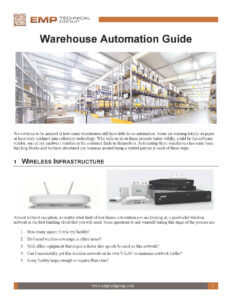We continue to be amazed at how many facilities have little to no warehouse automation. Some are running totally on paper or have very outdated data collection technology. Who calls us in on these projects varies wildly. It could be the software vendor, hardware vendor, or the customer finding us themselves. Automating these warehouses has some basic building blocks, and we have structured our business around being a trusted partner in each of these steps.
Wireless Infrastructure
Almost without exception, no matter what kind of warehouse automation you are looking at, a good solid wireless network is the first building block that you will need. Some questions to ask yourself during this stage of the process are:
- How many square feet is my facility?
- Do I need wireless coverage in office areas?
- Will office equipment that requires faster data speeds be used on this network?
- Can I successfully put this wireless network on its own V-LAN to minimize network traffic?
- Is my facility large enough to require fiber runs?
- Do I have power in my warehouse where it is needed for network cabinets?
- Does my warehouse software run terminal emulation, browser applications or thick clients?
Labeling Your Products
Maybe you have all of the labeling you need on your product now, or perhaps this will be a wholesale change in how you do business. Either way, here are some questions to ask:
- Am I am going to use license plates to track product in my warehouse?
- Am I going to label at the pallet, case or item level?
- Do I need to do lot traceability?
- Do I need to adopt FIFO?
- Will I use stationary or mobile label printers or both?
- What labeling software will I use to create the labels?
- Can I use direct thermal labels or do I need thermal transfer?
- Who in my operations is going to put the labels on the product?
Labeling Your Locations
You now have an excellent wireless network in place, and you have figured out the labeling of your products. What about labeling the locations? If you are going to automate your warehouse, you will need your locations labeled as well. Some questions to ask:
- Do you have rack or floor locations or both?
- If you have racking, will you need to scan higher locations from the floor level?
- If you have floor locations, do you want to use placards hanging from the ceiling or floor mounted bar codes?
- How high are your ceilings and can you hang placards directly from the roof beams?
- How granular do you want to get, every aisle of floor locations or general areas such as staging and zones?
- Do you have flow or push back racks that do not have cross beams and if so, how to label those?
- Who is going to do all of the labor to put location barcodes in your warehouse?
- What kind of numbering scheme are you going to use to identify all of these locations?
Mobile Computing
Now we are getting to the meat of things. What type of mobile terminals are you going to use? There are several to choose from, and here are some of the questions you should ask:
- How many of my workers will need to have a mobile computer?
- What kind of barcode scanner should I use, long range scanners, imagers for 2D bar codes?
- Should I use hand held terminals on my forklifts or permanently mounted forklift terminals?
- What OS is required by my warehouse software for mobile computers?
- Do I need a full screen and full Windows OS to run my warehouse software?
- Should I look at mobile power carts for my operations?
- Should I look at speech for my operations and does my warehouse software support this?
- How am I going to secure these mobile computers and make my workers responsible for them?
- How am I going to support these devices from an IT perspective, do I need a Mobile Device Management system?
These questions are just a start to ensuring a successful warehouse automation project. There is one thing for sure; the EMP Tech Group is here to help you as we have already helped hundreds of our customers successfully navigate the sometimes murky waters of warehouse automation. Contact us today, and we will come to your site to help you answer these questions.
